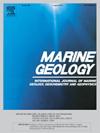An abrupt change in long-term shoreline behaviour at Roches Beach, Tasmania: An early response to contemporary climate change-induced sea-level rise?
IF 2.6
3区 地球科学
Q2 GEOSCIENCES, MULTIDISCIPLINARY
引用次数: 0
Abstract
This study analysed a 65-year air photo record for Roches Beach (Australia) which shows that after being mostly stable from at least 1946 until 1985, a major section of the shoreline abruptly switched to a net recession trend which persisted until 2011 when artificial sand replenishment began. Comparable changes have been identified on some other Tasmanian beaches but have only been rarely reported to date. At Roches Beach, consideration of potential causes has identified sea level rise (SLR) as the most plausible driver of the observed change, although increased wave height and vertical land movement (VLM) could also contribute. Climate change induced sea level rise is expected to eventually cause major recession of many shores, however most sandy beaches have not yet shown a clearly attributable response of this sort. We infer that the critical factor causing Roches Beach to undergo an early switch to shoreline recession in response to SLR is its mostly unidirectional littoral drift which transports sand into, through and out of its leaky embayment to a degree not seen in other beaches in the same coastal compartment of Frederick Henry Bay. This delivers a proportion of any eroded sand to the north end of the beach and beyond to a large sand sink at Seven Mile Beach. We deduce that the rising sea-level has increased the frequency and scale of upper beach erosion events, causing increasing net losses of eroded sand from the embayment until the formerly balanced sand budget changed to deficit. Storm records suggest that major erosion events abruptly tipped the beach into a recessional mode when its sand budget was close to deficit. Regional and local confounding processes that may prevent or overwhelm such responses to SLR are minor at this beach. These include swell wave directional variability and interannual sea level variability, both of which are minimal compared to many other Australian coasts. We contend that this allows sea level rise to be more persistently effective at changing the behaviour of Roches Beach than at many other sandy beaches where other causes of variability may be of sufficient magnitude as to mask or prevent persistent changes due to SLR. The factors identified as causing or allowing an early shoreline response to sea level rise will be widely applicable as indicators of other beaches likely to respond early to SLR. This underlines the importance of local studies to identify critical distinctions in susceptibility to SLR between what can be otherwise similar adjacent shores.
塔斯马尼亚州罗士海滩长期海岸线行为的突然变化:对当代气候变化引起的海平面上升的早期反应?
这项研究分析了澳大利亚罗士海滩65年的航空照片记录,结果显示,在至少从1946年到1985年基本稳定之后,一段主要的海岸线突然转变为净衰退趋势,这种趋势一直持续到2011年,当时人工补沙开始。在塔斯马尼亚的其他一些海滩上也发现了类似的变化,但迄今为止很少有报道。在罗士海滩,考虑到潜在的原因,已经确定海平面上升(SLR)是观测到的变化的最合理的驱动因素,尽管波浪高度的增加和垂直陆地运动(VLM)也可能有所贡献。气候变化引起的海平面上升预计最终会导致许多海岸的严重衰退,但大多数沙滩尚未显示出这种明确的可归因于的反应。我们推断,导致罗士海滩因SLR而早期转向海岸线退缩的关键因素是其主要是单向的沿海漂移,这种漂移将沙子输送到,通过和离开其渗漏的海湾,其程度在弗雷德里克亨利湾的同一海岸室的其他海滩中是看不到的。这将一部分被侵蚀的沙子输送到海滩的北端,并将其输送到七英里海滩的一个大型沙池。海平面上升增加了上滩侵蚀事件发生的频率和规模,导致侵蚀沙的净损失增加,直至原来平衡的沙收支变为赤字。风暴记录表明,当沙子收支接近赤字时,主要的侵蚀事件突然使海滩进入衰退模式。在这个海滩,可能阻止或压倒这种单反反应的区域和局部混杂过程是次要的。这些变化包括涌浪方向变化和年际海平面变化,与澳大利亚其他许多海岸相比,这两者都是最小的。我们认为,这使得海平面上升在改变罗士海滩的行为方面比在许多其他沙滩上更持久有效,在其他沙滩上,其他变化的原因可能足够大,可以掩盖或阻止由单反引起的持续变化。被确定为导致或允许海岸线对海平面上升作出早期反应的因素将广泛适用于其他海滩可能对SLR作出早期反应的指标。这强调了本地研究的重要性,以确定在其他方面相似的相邻海岸之间对单反的易感性的关键区别。
本文章由计算机程序翻译,如有差异,请以英文原文为准。
求助全文
约1分钟内获得全文
求助全文
来源期刊

Marine Geology
地学-地球科学综合
CiteScore
6.10
自引率
6.90%
发文量
175
审稿时长
21.9 weeks
期刊介绍:
Marine Geology is the premier international journal on marine geological processes in the broadest sense. We seek papers that are comprehensive, interdisciplinary and synthetic that will be lasting contributions to the field. Although most papers are based on regional studies, they must demonstrate new findings of international significance. We accept papers on subjects as diverse as seafloor hydrothermal systems, beach dynamics, early diagenesis, microbiological studies in sediments, palaeoclimate studies and geophysical studies of the seabed. We encourage papers that address emerging new fields, for example the influence of anthropogenic processes on coastal/marine geology and coastal/marine geoarchaeology. We insist that the papers are concerned with the marine realm and that they deal with geology: with rocks, sediments, and physical and chemical processes affecting them. Papers should address scientific hypotheses: highly descriptive data compilations or papers that deal only with marine management and risk assessment should be submitted to other journals. Papers on laboratory or modelling studies must demonstrate direct relevance to marine processes or deposits. The primary criteria for acceptance of papers is that the science is of high quality, novel, significant, and of broad international interest.
 求助内容:
求助内容: 应助结果提醒方式:
应助结果提醒方式:


